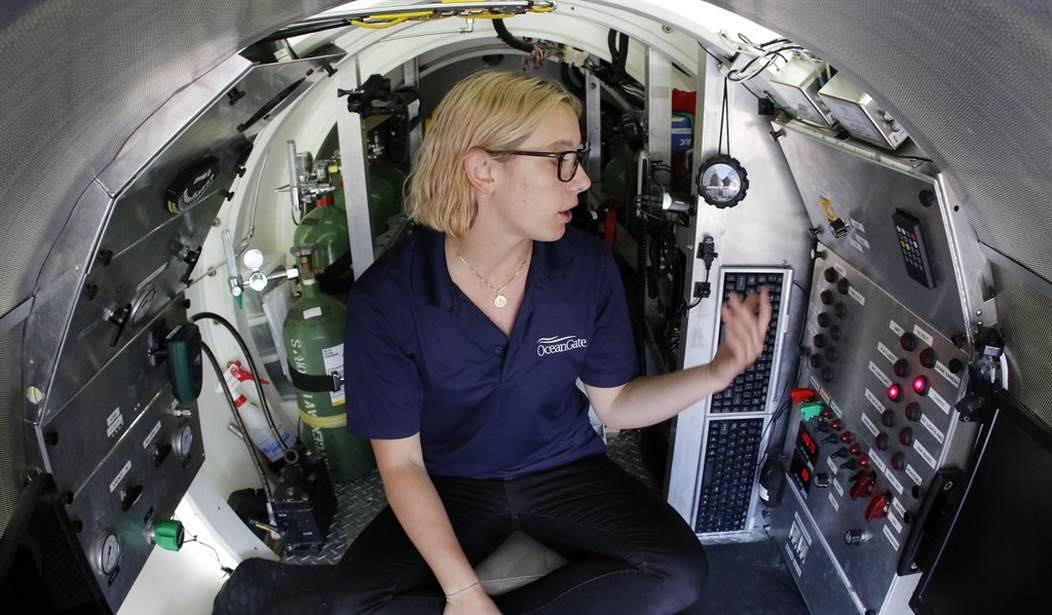The missing Titan submersible that descended beneath the waves to the Titanic wreck has run out of oxygen. The craft has life support systems that can last up to 96 hours. Those have expired. OceanGate, the company that finances these expeditions to the ocean liner, possesses the only five-man craft that can make the 12,500-foot journey to the wreck. The submersible vanished on Sunday, losing contact as some theorize a power failure crippled the ship. No trace of the craft has been discovered, but banging noises were detected on sonar late Tuesday night, offering hope that this mission remains a search and rescue. An unmanned robot supplied by France, which can travel to depths of up to 13,000 feet, had been deployed to find the Titan. It has an arm that can help surface the craft (via NY Post):
The missing Titanic-bound submersible containing five crew members will run out of breathable air by 7:08 a.m. EST Thursday, the US Coast Guard has projected.
The vessel, operated by OceanGate Expeditions, vanished Sunday morning in the waters off Newfoundland and officials on Monday said the submersible has a 96-hour supply of “emergency” oxygen.
A Coast Guard spokesperson told NBC News on Wednesday that the Titan’s oxygen reserve is expected to run dry Thursday morning.
Experts theorize that the five-person crew could be making last-ditch efforts to conserve the precious air as the oxygen supply hour countdown descended into single digits.
“It may be that they are conserving oxygen,” Jules Jaffe, a research oceanographer at the University of California, San Diego, who was part of a team involved in finding the Titanic wreckage in 1985, told the outlet.
[…]
The French government delivered its Victor 6000, a robot capable of diving 20,000 feet below sea level, to the area Titan vanished at around 6 p.m. Wednesday, with just 13 hours to scan the area for the missing sub.
The unmanned robot — which is one of the few vessels in the world capable of descending to the 12,000-feet-deep resting place of the Titanic — is equipped with a mechanical robot arm that could help drag the Titan back to the surface.
There’s another theory regarding the location of the missing Titan, which is that it was caught on the Titanic wreck, something that occurred to an ABC crew in 2000. Dr. Michael Guillen, who served as science editor at the time, said the incident almost got him killed:
Recommended
TITANIC ACCIDENT. When I was at ABC News, I became the first TV correspondent in history to report from the wreck of the Titanic at the bottom of the Atlantic Ocean, 2-1/2 miles below the surface. An accident happened that almost claimed my life. Here's what happened. #Titanic… pic.twitter.com/b4t3WtaRdc
— Dr. Michael Guillen (@DrMGuillen) June 19, 2023
Rescuers were adamant on Wednesday that the mission is still under the search and rescue category, but that might change today (via Associated Press):
Rescuers on Wednesday rushed more ships and vessels to the area where a submersible disappeared on its way to the Titanic wreckage site, hoping underwater sounds they detected for a second straight day might help narrow their search in an increasingly urgent mission.
Crews were scouring an area twice the size of Connecticut in waters 2 1/2 miles deep, said Captain Jamie Frederick of the First Coast Guard District, who noted that authorities are still holding out hope of saving the five passengers onboard the Titan.
“This is a search and rescue mission, 100%,” he said. ”... We’ll continue to put every available asset that we have in an effort to find the Titan and the crew members.”
But even those who expressed optimism warned that many obstacles remain: from pinpointing the vessel’s location, to reaching it with rescue equipment, to bringing it to the surface — assuming it’s still intact. And all that has to happen before the passengers’ oxygen supply runs out, which some have estimated might happen as early as Thursday morning.
The Titan no longer has breathable air, no one can exit the craft internally, and they’re 12,000-plus feet below the surface. There aren’t many options regarding safe retrieval, with the clock now at zero. And the health concerns inside the vessel with no oxygen aren’t positive either (via BBC):
As Dr Ken Ledez, a hyperbaric medicine expert at Memorial University in St John's, Newfoundland, has told BBC News that running out of air is not the only danger those on board face.
The vessel may have lost electrical power, which is likely to have a role in controlling the amount of oxygen and carbon dioxide inside the vessel.
As the oxygen level falls, the proportion of carbon dioxide being breathed out by the crew will be rising, with potentially fatal consequences.
"As levels of carbon dioxide build up, then it becomes sedative, it becomes like an anaesthetic gas, and you will go to sleep."
Too much of the gas in a person's bloodstream, known as hypercapnia, can kill them if not treated.
Former Royal Navy submarine captain Ryan Ramsey says he looked at videos online of the inside of Titan and could not see a carbon dioxide removal system, known as scrubbers.
"That for me is the greatest problem of all of them," he says.
At the same time, the crew are at risk from hypothermia, where the body gets too cold.
According to Capt Ramsey, if the sub is on the seabed, the water temperature will be about 0C. If it has also lost electricity, it will not be generating any power and therefore cannot generate heat.
The risks inherent with this trip are enormous, so many have called such trips suicide missions.

























Join the conversation as a VIP Member